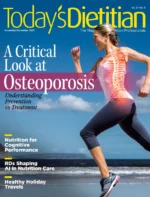Today’s Dietitian
Vol. 27 No. 8 P. 14
As food and nutrition experts, dietitians are well equipped to teach clients about nutrition and health and help them change their eating and lifestyle behaviors. Clients, however, must first have confidence in their practitioners before they will trust their explanations, accept their advice, and finally engage in behavior change.
The Hunt for Truth
Before the rise of social media, most people received similar information because news came largely from the major television networks and newspaper publishers. Today, in contrast, the internet and airwaves are rife with communicators, including bloggers, podcasters, social media influencers, Facebook friends, and others. Today’s information outlets often slant conservative or liberal. They may aim to speak to groups of specific age, religion, gender, or social class, leading people to hear and read what resonates with them and avoid anything that challenges their beliefs. “All of this leads to endless proliferation of so-called experts, constant confusion, and an environment where it’s difficult to establish credibility,” explains Charlie Arnot, CEO of The Center for Food Integrity.
A growing number of communicators offering contradictory or incompatible content exacerbates a natural inclination for many people to hold pseudoscientific beliefs. A 2020 article in Current Directions of Psychological Science identifies several reasons people may be motivated to hold beliefs that are inconsistent with consensus and evidence.1 Having a vested interest in a particular belief is one reason. For example, coffee-loving clients may reject evidence that caffeine disrupts sleep or contributes to heart palpitations because they do not want to alter their coffee-drinking behaviors. Additionally, clients’ social identities influence beliefs and behaviors. An avid gym-goer, for instance, may follow the diet and supplement trends of her group at the gym, regardless of benefit or scientific evidence. She mimics them as a signal that she belongs to the group. Likewise, someone may spend a lot of money on a green juice detox program that’s purported to reduce inflammation and restore a healthy microbiome because that’s the trendy thing in her tight friend group. She may later reject the dietitian’s warning not only because of her social identity but also because of vested interests of wanting to avoid the feeling of being wasteful with money and her efforts at detoxing.
Dietitians Must First Earn Trust
Dietitians cannot expect clients to accept advice about behavior change before earning the clients’ trust. Where once the general public may have trusted RDs and other health care professionals based on their training, titles, and positions, the nearly infinite number of people with a voice in the food and nutrition space means RDs today must earn trust differently. Credentials and job titles aren’t enough. “Truth is now shaped by belief-based communities,” Arnot says. “Various microcultures define their own truth.”
Research looking at five areas of the US food system, including food safety and nutrition, finds that shared values are three to five times more important than facts and skills in building trust.2 “A person like me,” Arnot explains, “is trusted at least as much as an expert.” He argues that dietitians may lack permission to share science before they make a connection.
Know Your Audience
The ways in which RDs make connections and build trust will differ based on the given scenario and individual or group they work with. Research surrounding food and agriculture communications from The Center for Food Integrity identifies several belief-based consumer segments.3 Three segments are briefly described below.
The Rationalist
The rationalist may make up only about 19% of the US population. Rationalists are people for whom data and facts are most important. They may schedule an appointment with a dietitian specifically because of a respect for the credential and job title.
The Authenticity Seeker
The authenticity seeker may be found in around 14% of the population and values transparency and firsthand accounts. They find truth in unfiltered experiences of real people. The authenticity seeker is less likely to engage with or trust large corporations.
The Comfort Seeker
The comfort seeker makes up the largest group—approximately 43% of the population—and trusts sources that resonate emotionally and can break down complex ideas into easy-to-follow advice. They primarily seek emotional reassurance that they’re making good choices about food, nutrition, and agriculture. “They’re as likely to trust their grandma, an online influencer promoting a super food, or a registered dietitian,” Arnot says.
How Dietitians Make Connections
For Christy Wilson, RD, owner of Christy Wilson Nutrition, making a connection starts with asking appropriate questions and being a good listener. Some of her patients hold beliefs that are counter to the evidence. By asking them about their beliefs and learning about their perspective, Wilson shows she respects their point of view and offers a safe, nonjudgmental space for communication and learning.
“It’s tempting to give people more and more facts to convince them, but it doesn’t work,” she says. “Proverbially hitting people over the head with facts without understanding the when, why, who, and how someone came to believe what they do only leads to our own frustration as health practitioners and will likely only lead to a client’s resistance.”
Arnot acknowledges that RDs may be uncomfortable when they hold back from arguing facts with a client who believes false information. He says RDs can maintain ethical standards without alienating a client by validating the client’s concerns without validating the client’s beliefs.
In many cases, making a connection can be very simple and take only seconds. For example, saying, “It sounds like food safety is important to us both,” instead of “Research now says it’s safe to cook pork roasts to just 145°F,” helps a client feel understood. A blogger can quickly make a connection with readers by sharing a story or a concern, opening the blog post with something that answers the question: as the reader, what’s in it for me?
Journalist Karen Ansel, MS, RDN, finds success reaching broad audiences by using easily understood language and imagining the lives and problems her readers face. “For example, they may be interested in eating healthfully and cooking but may not actually have the time or the resources to do this,” she says. To build connection, she assumes up front that they may be living with these obstacles and writes as empathetically and inclusively as possible.
Dawn Jackson Blatner, RDN, CSSD, an expert in media communication and sports nutrition says she connects with live, television, and other virtual audiences by “ditching the jargon and instead turning science into stuff I’d want to tell a friend. I talk with the audience, not at them. And I always think: how can I make this feel more like a memorable conversation than a lecture?” Blatner adds that audiences want connection rather than perfection from their speaker. Instead of speaking as a polished authority, she recommends dietitians help their audiences to feel smart and empowered. Audiences relate to a speaker who shows up authentically, tells real-life stories, and appears approachable, she says.
In many cases, multiple interactions are needed to build trust. An authenticity seeker skeptical of medical nutrition therapy, for example, may become motivated to adopt new behaviors by being encouraged by the RD to take on changes as a short-term personal experiment. This allows the client the firsthand experience necessary for their understanding of truth.
Conclusion
Facts are the basis of a dietitian’s work and career. However, without a common information culture, facts alone won’t drive behavior change in most clients. RDs must ask questions, validate the concerns of clients and patients, and tailor their approaches by finding shared values.
— Jill Weisenberger, MS, RDN, CDCES, CHWC, FAND, is the author of several books, including Prediabetes: A Complete Guide, 2nd Edition.
References
1. Hornsey MJ. Why facts are not enough: understanding and managing the motivated rejection of science. Curr Dir Psychol Sci. 2020;29(6):583-591.
2. Sapp SG, Arnot C, Fallon, J, et al. Consumers trust in the US food system: an examination of the recreancy theorem. Rural Sociol. 2009;74(4):525-545.
3. New research reveals how consumers define “truth” in food & agriculture. The Center for Food Integrity website. https://foodintegrity.org/new-research-reveals-how-consumers-define-truth-in-food-agriculture/. Published April 8, 2025.



